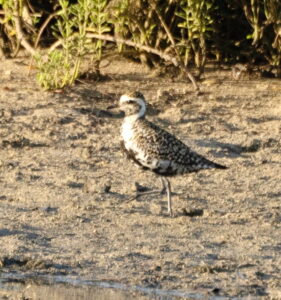
Paiko Lagoon, May 4, 2025 ©Roger Kobayashi
May 6, 2025
Because I spent most of April in Australia, I missed seeing our kōlea all dressed up and strutting their stuff. Even so, fellow shorebird fans kept me up to date with observations and comments about behavior changes, gatherings, and liftoffs. They also had questions.
The most common thing plover lovers wonder is where we might go to see Hawaiʻi’s plovers gather before departing for Alaska.
Good question. The first time I heard of the birds’ gathering was at Kualoa Regional Park. Years ago, plover expert Wally Johnson told me about driving there near the end of April, seeing a flock and parking, determined to watch them lift off. After waiting several hours, he fell asleep. When he awoke, the birds were gone.
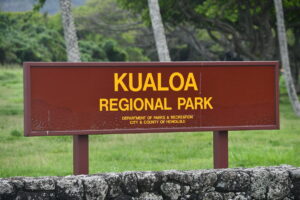
Because of Wally’s long-ago story, I’ve gone to this park in mid-to-late April for years. But timing is everything, and the birds have not cooperated. I’ve not seen a gathering there.
It’s easy to see kōlea at Midway Atoll, as shown below in this outstanding photo by U.S. Fish and Wildlife biologist, Dan Rap. The picture was included in a Friends of Midway Atoll newsletter, well worth joining for news and photos of the great albatross grandmom, Wisdom, as well as other happenings there.
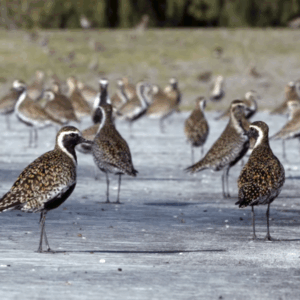
Kōlea gathering, Midway Atoll, April 2025. ©Dan Rap, USFWS.
We can’t go to Midway Atoll (closed to the public) to see kōlea flocking, but fans report gatherings at some Oʻahu sites. Roger Kobayashi, a retired civilian accountant at Pearl Harbor kindly drove me the previous two years to Ford Island and to the grounds of Tripler Army Hospital to see the impressive gatherings there. This year at Tripler, Roger counted 82 plovers on April 22nd, three and April 23rd, and zero on April 25th.
The rub is that you need military ID to enter both places.
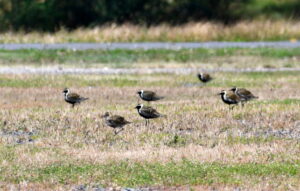
Kōlea in April last year, Ford Island. ©Susan Scott
Another kōlea fan (and extraordinary Hawaiʻi Audubon volunteer), Laura Zoller, saw a flock in the air (below) on April 24th off Marconi Point, on Oahu’s North Shore. Laura only had her phone camera so the photo is small, but she could see they’re kōlea.
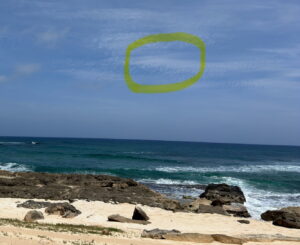

We don’t know the circumstances that prompt flocking or liftoff. It’s not likely local weather conditions because the birds have no way of knowing what’s happening with upper atmospheric winds or the snowmelt situation in their Alaska breeding grounds. One theory is that springtime’s gradual lengthening of daylight triggers hormonal changes that cause the birds to molt and migrate.
Some birds leave our backyards in mid-April, probably to join a gathering. Our 9-year-old male, Jake, usually disappears around April 12th or 13th. Another kōlea named Lady, who has been visiting the same Honolulu yard for 11 years, left on April 11th. Her yard’s owner reported that the bird began making unusual cheeping sounds in the evenings a few days before she left. Might she, he wondered, be communicating with other kōlea flying over? Or were her reproductive hormones making her restless? Only the birds know.
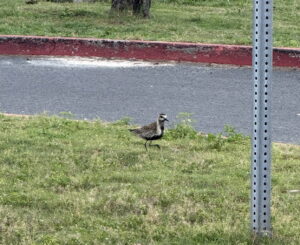
My beach park kōlea, named Roundy because she forages in a round-about in Kailua Beach Park, was a late-leaver. She was still here on Friday, May 2nd, but is gone now. ©Susan Scott
Kōlea fan Naomi sent the picture below on May 2nd saying the bird is limping and can we help it? I wrote to Naomi that it’s extremely hard to catch a plover with 2 good wings, but some individuals with one bad leg survive.
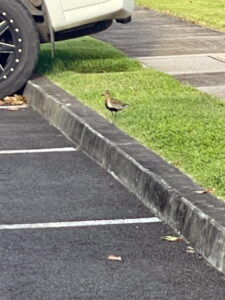
Naomi replied, “I love these birds so much, I just want them all to thrive! I’ll be keeping tabs on her.”
Thank you all for loving our kōlea and keeping tabs them. It’s how we’ll get answers to our questions.
Record observations in the REPORT tab at KoleaCount.org